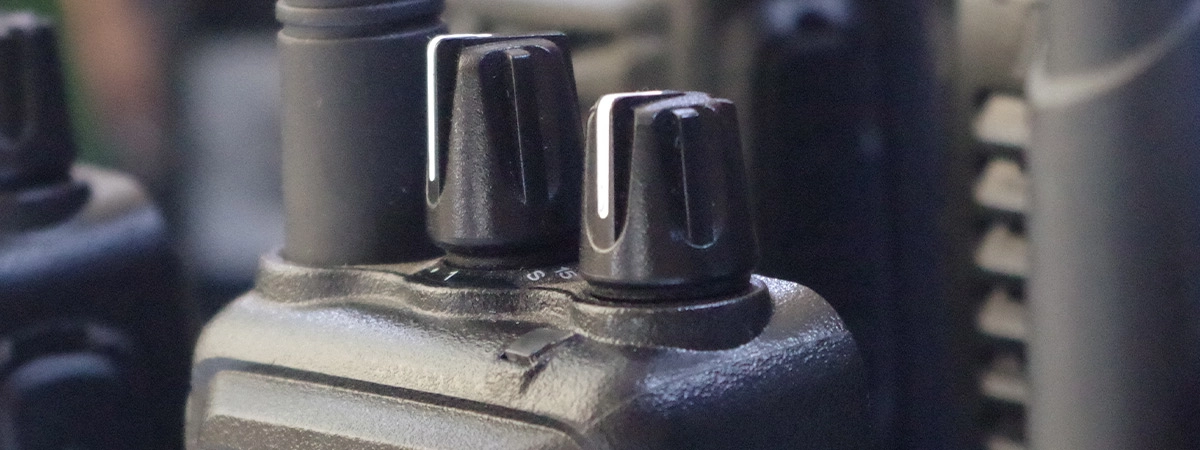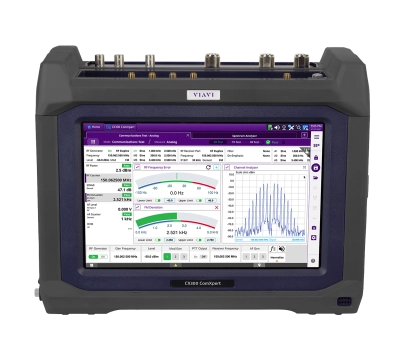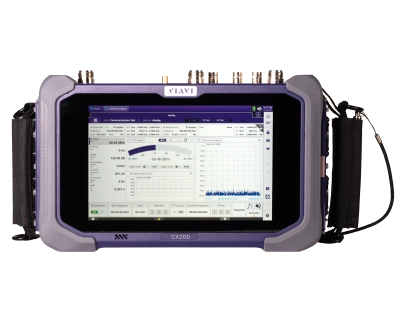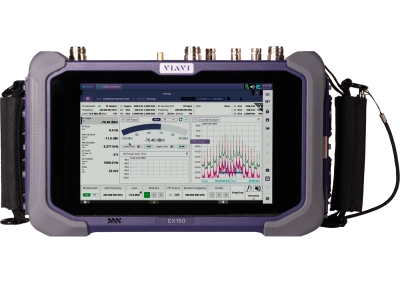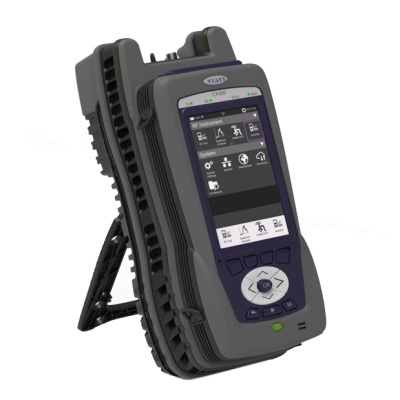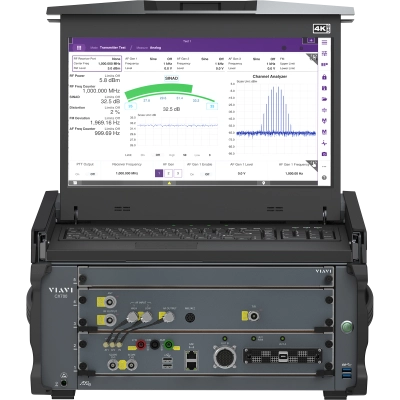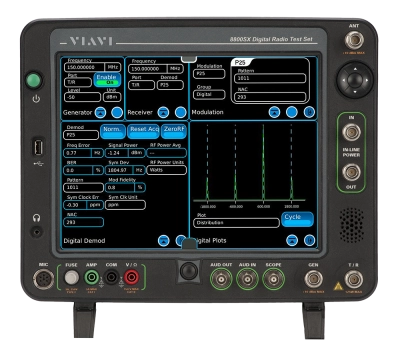Communications Service Monitors
Industry-Leading Radio Test Equipment
Products
-

CX300 ComXpert Communications Service Monitor
Our most advanced service monitor, featuring full analog and digital support, plus AutoTest for rapid subscriber...
-

CX200 SiteXpert Communications Service Monitor
Lightweight handheld for field and infrastructure testing, combining portability with powerful performance.
-

CX150 ComLite Communications Service Monitor
Compact and reliable analog handheld, delivering essential test functions with simplicity.
-

CX100 ComXpert Handheld Communications Service Monitor
Rugged, handheld analog tester built for tactical field use in the harshest environments.
-

CX700 ComXpert Radio Test System
An automated radio communications test solution for commercial, tactical, and military applications in production,...
-

8800SX Digital Radio Test Set
Advanced Analog and Digital Radio Test Set for Bench and Field Environments
Service Monitors from VIAVI
Mobile radio communication provides an essential linkage for industries ranging from emergency response to public transportation. Mission-critical voice communication requires the support of accurate, flexible, and comprehensive testing and maintenance. Communications service monitors provide the most powerful and efficient multi-purpose test solutions for land mobile radio technologies.
VIAVI has established an unrivaled standard for communications service monitor performance by automating radio test and alignment functions and incorporating valuable options such as high-power RF sensors, vocoders, and advanced digital test features. The unique capabilities and options found only in communications service monitors from VIAVI extend throughout the product family, from benchtop to handheld.
A Communications Service Monitor (CSM) is an integrated radio communication test solution combining the functionality of a signal generator, spectrum analyzer, oscilloscope, channel analyzer, power meter, and other analog and digital radio test functions into one multi-purpose, stand-alone instrument. Advanced computing and electronics have enabled communications service monitors to be more portable, efficient, and accurate to better align this powerful technology with the dynamic and diverse radio communications ecosystem.
The versatility of a modern communications service monitor expands the paradigm of a traditional radio test set to include power, modulation, and frequency analysis for both analog and digital land mobile radio (LMR) applications. Cable fault analysis, antenna testing, and infrastructure commissioning are additional service monitor capabilities that have remained relevant in the modern era of radio communication.
Base station and repeater installations that continue to multiply also leverage the advantages of these high-performance radio test systems.
Mobile radio was first deployed on ocean-going ships over 100 years ago, replacing the carrier pigeons and flags that had provided the only communication links with the shore or other vessels for centuries. This was the first of many important applications that made mobile radio an intrinsic element of modern society.
Non-broadcast two-way radio used for public-safety first responders, aviation communications, utilities, the military, and the transportation industry are among the numerous use cases realizing a significant return on investment (ROI) from this communications service monitor investment. The clientele for mobile radio communication includes emergency medical services (EMS) and hospitals that depend on consistent signal quality and coverage in potential life-and-death situations. Two-way radio dealers and radio service and repair establishments are other potential beneficiaries of cutting-edge CSM technology.
Despite the obvious feature set advantages of today’s cellular technology, land mobile radio remains an indispensable tool for reliable, split-second emergency communication. Many of these organizations require Project 25 (P25) or Terrestrial Trunked Radio (TETRA) interoperability protocols to be followed. A VIAVI communications service monitor can reliably verify conformance to these protocols and characterize all performance aspects of emergency radio.
The railroad industry has evolved in parallel with radio technology over the past 150 years. Railroad operators are now required to remotely monitor and control their trains to establish the highest possible level of safety. VIAVI provides a Positive Train Control (PTC) option for portable CSM instruments that allows Class 1 and passenger train operators to test the RF parameters of their systems in the lab and field to ensure compliance to these stringent railroad safety standards.
Range, security, and reliability standards originating on the battlefield have been key driving factors in the development of land mobile radio technology since World War I. The U.S. Department of Defense (DOD) recognizes the importance of digital radio communication in improving interoperability between military branches, tactical flexibility, and adaptability to mission requirements. Two-way radio test equipment from VIAVI supports these requirements through digital modulation diagnostics, repeater testing, and precise audio spectral analysis.
The innumerable benefits provided by communications service monitors extend from the lab to the field. By integrating the functionality and accuracy of multiple complex instruments into one compact package, numerous development, test and validation activities can be automated and streamlined. This “all-in-one” strategy also alleviates the rack and counter space shortages commonly encountered in R&D settings.
The many capabilities of a versatile and portable communications service monitor allow coverage quality to be verified through field preventative maintenance and inspection. Without adequate maintenance, communications can break down and coverage can be severely impacted.
In digital networks, improper alignment can influence the modulation accuracy and degrade coverage quality. Two-way radio test equipment can be used to properly diagnose the misalignment that increases bit error rate (BER) and compromises modulation fidelity. This diagnosis can prevent unnecessary deployment of additional antenna sites or other resources intended to boost coverage.
Advanced two-way radio service monitors can seamlessly move from radio testing to radio alignment. Automation of functions creates significant efficiency gains: radio alignment processes that once consumed hours of valuable technician time are reduced to a matter of minutes with minimal human intervention. In addition to modulation accuracy testing for digital communications, the technical prowess of an advanced communications service monitor creates an ideal solution for signal coverage mapping, frequency testing, power measurement, audio performance, and radio sensitivity level testing.
Along with traditional AM/FM analog radio testing, communications service monitors can be used to verify conformance to the interoperability, coverage, and performance requirements of digital communications standards such as Project 25 (P25). Established in 1989, P25 provides a framework for the digital two-way radio communication products and practices of first responders and other public safety categories.
Phase 1 of P25 utilizes the same bandwidth as narrow band FM radio, while Phase 2 has incorporated time division multiple access (TDMA) technology for greater spectral efficiency. P25 Phase 2 remains backwards compatible with Phase 1 technology.
Terrestrial Trunked Radio (TETRA) is an international land mobile radio standard developed by the European Telecommunications Standards Institute (ETSI) in 1995. TETRA has been adopted by emergency services, police and other government entities as well as private sector customers in transportation and logistics. TETRA radios utilize voice encryption for added security and direct push-to-talk functionality for expedient emergency transmission. TDMA technology finds congruity within the 25 kHz TETRA channel bandwidth along with Differential Quadrature Phase Shift Keying (DQPSK) modulation. Other technologies that can be effectively tested by a service monitor include Digital Mobile Radio (DMR), Next Generation Digital Narrowband (NXDN) and Digital Private Mobile Radio (dPMR).
Developed by the ETSI in 2005, DMR has become a standardized low cost and low complexity solution for professional mobile radio. As a result, DMR has helped provide an upgrade path from analog FM to digital radio.
NXDN was developed in 2005 as part of an FCC initiative to migrate away from the crowded 12.5 kHz spectrum. Since that time, NXDN popularity has continued to grow across multiple business sectors.
dPMR, developed by the ETSI, provides a low-cost solution for personal and private mobile radio applications. Like NXDN, the non-proprietary dPMR standard has alleviated channel shortage concerns by shifting to the 6.25 kHz spectrum.
CSMs have evolved to meet the needs of each use case and technology being tested. Feature sets have expanded as more capabilities are incorporated into versatile radio test instruments. These improvements have brought more capability to the field while minimizing the need for multiple stand-alone test instruments.
The exceptional accuracy and versatility of all benchtop, portable, and handheld VIAVI radio test equipment offerings exceed the requirements of commercial, public safety, and military users.
Benchtop Communications Service Monitors
With a comprehensive menu of powerful analog test capabilities, up to 2.7 GHz frequency range, and the largest selection of digital radio options of any radio test set on the market, the 3920B Series radio test platform has become the industry standard benchtop communications service monitor.
User-friendly Auto-Test and alignment capabilities support technologies including P25, TETRA, NXDN, and dPMR. The 3920B radio service monitor also includes a built-in 4 MHz dual channel oscilloscope, a full span spectrum analyzer and an interactive audio analyzer. As the only available communications service monitor to incorporate Vocoder technology for multiple protocols, the 3920B allows the user to see and hear digital audio signals simultaneously.
Portable Communications Service Monitors
Bridging the gap between the performance and features of benchtop radio test instruments and the compact form factor and ruggedness of portable field-level equipment is the 8800SX digital radio test set. Fully automated test and alignment capabilities have been integrated into this 17 lb, battery-operated radio test solution. An internal audio oscilloscope, channel analyzer, and audio function generator provide complete test coverage for analog radio.
Digital test features include test patterns, voice quality verification, and advanced modulation plot analysis to meet the critical test, monitoring, and maintenance requirements of all major digital LMR technologies. An optional 500W in-line RF power meter is a unique feature of the 8800SX that enables testing of high-power transmitters and cable/antenna deployments at remote repeater sites without adding an additional instrument.
Handheld Communications Service Monitors
The portability, ultra-light form factor, and exceptional battery performance of the 3550R touch-screen radio test system marks the first appearance of feature-rich communications service monitors in the handheld device category. The ultra-responsive, resistive touch screen simplifies cable and antenna testing while driving a full suite of RF test capabilities including a multi-function oscilloscope, analog and digital demodulation measurement, and precision power metering.
The 3350R supports test functions for all major land mobile radio technologies in thirteen common languages. With a new level of rugged portability proven to resist temperature extremes, drops, and long service intervals in the field, the 3550R has expanded the scope of handheld two-way radio service monitor performance.
Combining the functionality and precision of disparate radio test equipment into a singular package no longer requires an oversized form factor or an unlimited budget. The humble origins of mobile radio communication have given way to an expanded universe of technologies, efficient channel utilization, and the widespread adoption of digital radio. Fortunately, the test solutions required to support this rapid advancement have kept pace with unprecedented feature set diversity and automatic test functions now available even in field-ready radio service monitors.
While leading the way through technology, innovation, and experience, VIAVI is also advancing the communications service monitor market with the widest available selection of OEM-approved Auto-Test features. VIAVI works closely with the manufacturers who develop and produce the radio equipment we rely on for our safety, health, transportation, and national security. These partnerships lead to radio communication methods developed in the lab becoming fully maintainable by advanced service monitors in the field.
Support at Every Step
We provide support, services, comprehensive training and the resources you need. It’s all part of what we do to maximize the value of your VIAVI investment.
Ask an Expert
Contact us for more information or to receive a price quote. We have the experts to give you the right answer on any of your questions.
